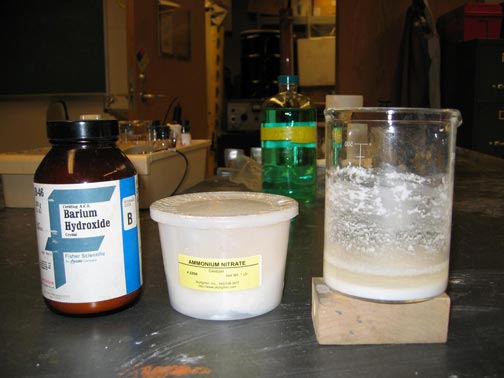The joining of wood and glass with water and salt
 An erlenmeyer flask containting water is placed on a wet wooden block. When salt is dissolved in the flask the wooden block bonds to the flask through the freezing of the water.
An erlenmeyer flask containting water is placed on a wet wooden block. When salt is dissolved in the flask the wooden block bonds to the flask through the freezing of the water.
Ingredients: barium hydroxide, ammonium nitrate, beaker, wooden block
Procedure: A complete recipe follows.
1. Wet block with water and place beaker atop water.
2. Mix 32 grams of solid barium hydroxide with 17 grams of solid ammonium nitrate in beaker.
3. Stir mixture and allow reaction to proceed.
4. Lift beaker to demonstrate attachment of block to the beaker's bottom.
Understanding: The reaction of barium hydroxide with ammonium nitrate is an acid/base reaction that yields ammonia and water as products
Ba(OH)2·8H2O(s) + 2 NH4NO3(s) → 2 NH3(g) + Ba2+(aq) + 2 NO3-(aq) + 10 H2O(l)
The reaction is strongly endothermic and can produce reductions in temperature by as much as 40C!The sharp drop in temperature causes the water between the beaker and wooden block to freeze, binding the beaker and wooden block. The beaker can be raised to demonstrate this fact, carrying the wooden black on its bottom.
Rules of thumb regarding the thermodynamics of the dissolution of salts
Question: The process of mixing water with most salts is exothermic. However, when an anhydrous salt is created from its hydrate, the process is endothermic.Using your knowledge of intermolecuular forces, rationalize these statements.
You can check your answers here.